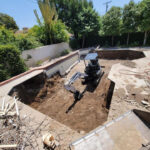Making the decision between renovating an existing structure or demolishing it completely can be challenging for property owners. While renovation might seem like the more economical and less disruptive option initially, there are circumstances where professional home demolition is not only the safer choice but also the more financially sound decision in the long run. This comprehensive guide explores five key indicators that suggest your property might be better suited for demolition rather than renovation.
1. Extensive Structural Damage
Perhaps the most definitive sign that demolition should be considered is the presence of significant structural damage. When a building’s fundamental integrity is compromised, attempting to renovate becomes not only expensive but potentially dangerous.
Foundations that have experienced severe cracking, shifting, or sinking present a particularly troubling scenario. When the very base of your structure is failing, repairs often require extensive underpinning or complete foundation replacement—procedures that can quickly surpass the cost of demolition and new construction. Similarly, load-bearing walls that show signs of failure represent a serious structural concern that renovation might not adequately address.
Water damage that has persisted over time can lead to deterioration of essential structural elements. When wooden support beams and joists have rotted or steel structural components have corroded beyond reasonable repair, the cost-benefit analysis typically favors starting fresh. Extreme roof damage that has compromised the structural framework below also falls into this category of problems often better solved through demolition.
According to home demolition contractors, when repair costs for structural issues exceed 50% of the building’s value, demolition generally becomes the more economical choice. Professional structural assessment should be your first step in making this determination, as engineers can provide detailed analysis of repair feasibility versus replacement costs.
2. Pervasive Hazardous Materials
Older properties often contain materials now recognized as health hazards that require specialized and costly remediation. The presence of these substances throughout a structure can make renovation prohibitively expensive compared to demolition and rebuilding.
Extensive asbestos found in insulation, flooring, ceiling materials, and siding presents significant health risks and removal challenges. Professional asbestos abatement is extremely costly, especially when the material is widespread throughout the building. Lead paint, common in homes built before 1978, poses similar concerns when present on multiple surfaces throughout the property.
Severe mold infestations that have penetrated wall cavities, subflooring, and structural elements often cannot be completely eliminated through remediation alone. The Environmental Protection Agency notes that when mold coverage exceeds 10 square feet or has penetrated building materials, more extensive intervention becomes necessary.
Chemical contamination from previous industrial use, methamphetamine production, or other sources can permeate building materials in ways that make decontamination nearly impossible. In these situations, demolition provides the cleanest slate for creating a safe living or working environment.

3. Outdated and Inefficient Systems
Buildings with thoroughly outdated infrastructure often reach a tipping point where replacement of multiple systems simultaneously makes demolition the more practical approach.
Electrical systems that don’t meet current code requirements—particularly knob-and-tube wiring or inadequate service panels—present both safety hazards and functional limitations for modern living. Plumbing systems with widespread galvanized or lead piping similarly require comprehensive replacement rather than spot repairs.
Heating, ventilation, and air conditioning (HVAC) systems that have reached end-of-life status throughout the building represent another substantial replacement cost. When combined with poor insulation, inadequate vapor barriers, and outdated energy efficiency standards, the cumulative expense of bringing these systems up to modern performance expectations can be prohibitive.
Energy efficiency experts emphasize that comprehensive energy retrofits of older buildings typically recover costs over 7-10 years. However, when multiple systems require simultaneous replacement, the return on investment timeline extends significantly, often making new construction the more economically viable option.
4. Functional Obsolescence and Poor Layout
Some properties suffer from design and layout issues so fundamental that renovation cannot reasonably address them without essentially rebuilding from scratch.
Buildings with ceiling heights well below current standards (typically less than 8 feet) create spaces that feel cramped and cannot be easily modified without structural alterations. Similarly, properties with room dimensions significantly smaller than contemporary expectations may feel perpetually claustrophobic despite cosmetic improvements.
Dysfunctional floor plans with poor flow, excessive load-bearing walls preventing reconfiguration, or layouts incompatible with modern living patterns represent another category of problems difficult to solve through renovation alone. When architectural redesign requires removing or relocating multiple load-bearing walls, costs escalate rapidly.
Real estate professionals suggest that maintaining competitive property values requires meeting minimum functional standards for the neighborhood. According to Remodeling Magazine’s Cost vs. Value Report, major structural renovations typically return only 50-60% of their cost in added value, whereas appropriately sized new construction can capture full market value.

5. Cost-Benefit Analysis Favors New Construction
The final determining factor often comes down to straightforward financial analysis when comparing renovation versus demolition and rebuilding.
Professional estimates indicating renovation costs exceeding 75% of new construction costs generally suggest demolition as the more economical approach. This threshold becomes even more compelling when renovation would still leave certain outdated or problematic elements in place.
Insurance and financing considerations also play important roles in this decision. Many insurance companies charge higher premiums for properties with outdated systems or materials, while renovation loans often come with higher interest rates and more restrictions than new construction financing.
Future maintenance projections represent another crucial factor. Even extensive renovations cannot change the fundamental age of original components that remain, meaning ongoing maintenance costs will likely remain higher than with new construction. When combined with energy efficiency advantages of modern construction techniques, the long-term operational cost savings can be substantial.
Real estate market analysis in your specific area should inform this decision as well. In neighborhoods where new construction commands significant premium over renovated properties of similar size, the financial case for demolition strengthens considerably.
Final Thoughts
While the decision to demolish rather than renovate carries emotional weight, especially for properties with historical significance or personal attachment, pragmatic assessment of these five key factors can provide clarity about the most responsible path forward. Professional consultation with structural engineers, contractors experienced in both renovation and new construction, and real estate valuation experts can help quantify the considerations outlined above.
When structural integrity has been severely compromised, hazardous materials permeate the property, multiple systems require simultaneous replacement, functional obsolescence limits usability, or cost-benefit analysis clearly favors new construction, professional home demolition represents not only the safest choice but often the most financially sound decision for property owners looking to maximize long-term value and functionality.
For more information about professional demolition services in your area, contact Earthworks Engineering today at 909-845-2319 for a free consultation.









